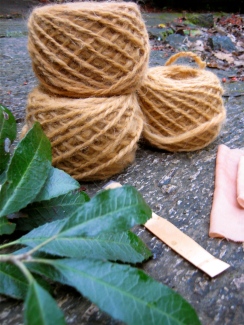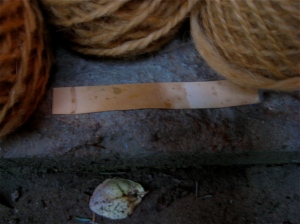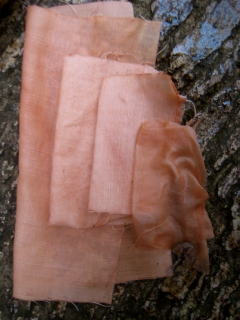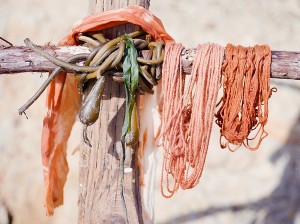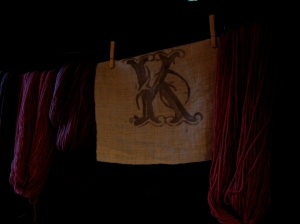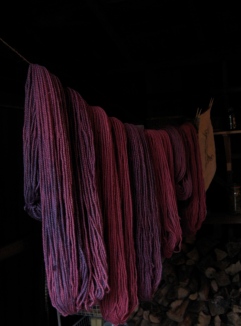Toyon & Chromatography
January 9, 2011
Have you ever wanted to assess the plant species in your region for natural dye capability? I certainly have! I also have had the interest to see if there are colors that I have not achieved in the dye vat that are secretly hiding out somewhere… waiting for the right protocol. For these reasons I started collaborating with a local biology professor and doing some very basic chromatography experiments.
Through the harvest of just a handful of plant material you can conduct a simple experiment to see what colors lay beneath the surface.
Here lay three handspun toyon dyed skeins, and s sprig of the plant, along with a chromatography strip. The definition of chromatography… ‘a process used for separating mixtures by virtue of differences in absorbency’…
The chromatography strips created with toyon leaves were representative of many of the colors that I have already discovered. The bulk of the color on the strip is a rusty orange– which is a common color achieved with toyon dye. Towards the end of the strip, there is a small area of pink— a very new and curious color!
I began to play with the water of cooked berries (which are edible if roasted or boiled), and achieved these colors (as seen below)..
These pinks were abundantly available from the berry water, and showed up on linen, silk, and cotton samples. My question was if it was possible to achieve the pink tones without the use of berries, (I prefer not to use berries for dye– because they are such a nice food source for birds and people).
This experiment is being continued… and was further explored at the seaside day of dyes. I brought toyon leaves and stems that had soaked on slow heat for days..and within a copper pot. Something about the copper, ocean water, and leaves, all combined– yielded some exquisite results, far beyond a simple orange or pink.. the color lived somewhere between the two. If I had not experimented with the chromatography I’d have had no sense that these colors were possible… the beauty of the scientific process, is that it shows you what might be available to you in the dye pot. You are, of course, then left with how to achieve those results, and that is often where the fun begins.
The experimenting continues.. and if you’d like to try your own chromatography experiment:
Grind 5 or 6 leaves in mortar and pestle
Cover the leaves in alcohol (medical grade)
Let sit for 24 hours or longer
Pour liquid into a test tube
Place chromatography paper into the test tube, cover, and wait
I recommend several days, even a week of absorption before removing the paper
Frozen Pokeberries & Oak Galls
January 1, 2011
Its a bit cold, and as you can see from this picture.. it’s dark too! The winter has moved many dye processes inside. As it started to rain a few moments ago, I pulled everything off the dry line and moved into the studio/garage. The wool has just come from a dye bath of vinegar and my frozen pokeberry harvest. (My gorgeous 7 ft. tall plant, was dripping with berries this last autumn), I froze them and was waiting for the perfect wool to dye them in. These skeins are from Reba, a lovely merino sheep who lives in Mendocino County, CA.
The letter K is a screen print that my brother and I created for my mother (Kerry), for Christmas. I made a glorious ink with galls from a very manganese rich soil. This ink has become a silk screen dream. I am very happy with the outcome. It can undergo all kinds of washing and still hold a solid slate gray tone.
As you can see here the pokeberry wasn’t the only dye color I used. As I began to exhaust the bath, the pink turned lighter and lighter, so I quickly dipped a few of these into my indigo vat– giving a modeled and violet hue to the wool. I can’t wait to see this wool turn into the designer dress that its being created for! More on that later..

